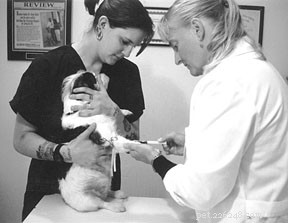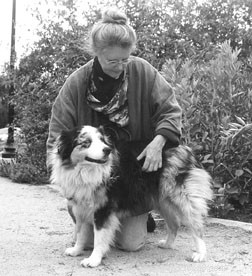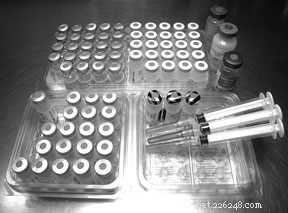
– 신선한 음식, 충분한(반드시 격렬한 것은 아님) 운동, 일광 및 애정 어린 실천적 관심으로 개의 면역 체계를 지원하십시오.
- 과잉 예방 접종을 하지 마십시오! 역가 테스트를 사용하여 개의 면역 "기억"이 "증진"이 필요한지 여부를 결정하십시오.
– 개의 만성 건강 문제를 면역 체계의 균형을 맞추기 위해 추가 조치를 취해야 한다는 신호로 간주합니다. 이와 관련하여 보완 요법이 탁월합니다.
면역 체계는 개의 "훌륭한 보호자"입니다. 면역(라틴어 immunis에서 유래) , 면제 또는 면제를 의미함)은 특정 또는 비특이적 메커니즘에 의해 전염병으로부터 보호되어야 합니다.
외부 세계의 감염성 도전과 항원 자극에 대응하고 적절하게 대응하는 것은 위대한 보호자의 임무입니다. 적절한 면역 반응은 숙주 동물 자체를 파괴하지 않으면서 신체의 도전자에 대한 방어를 구축할 것입니다. 이러한 유형의 반응은 면역 체계가 자신의 "자기"를 침입자, 즉 "자기가 아님"을 인식하거나 구별할 수 있다는 것을 전제로 합니다.

면역계에 대한 연구에는 면역 현상의 모든 생물학적, 혈청학적, 물리적 및 화학적 측면과 함께 기본 구조 및 기능이 포함됩니다. 또한 면역 기능은 예방 접종(백신), 장기 이식 및 수혈에 관여합니다.
면역 체계의 기능 검사에는 면역학의 세포 및 체액("체액" 또는 체액 관련, 특히 혈액 관련) 성분에 대한 실험실 검사와 항원-항체 반응(혈청학 및 면역화학)의 사용이 포함될 수 있습니다. . 수행하기 쉬운 임상 병리 검사(예:CBC 또는 바늘 생검)를 사용하여 동물의 면역 체계의 현재 상태를 표시할 수 있습니다.
개의 면역 체계의 물리적 부분은 세포 이하 수준에서 전체 유기체로 확장됩니다. 각각의 모든 세포와 모든 기관 시스템은 자체 면역 구성 요소를 가지고 있으며, 차례로 각각은 일종의 독립적인 내부 조절기를 가지고 있습니다. 최근 증거에 따르면 동물의 감정은 동물의 면역에 때로는 긍정적으로 때로는 부정적으로 깊은 영향을 미칩니다. 그리고 소음, 냄새, 빛 패턴 및/또는 환경 오염 물질과 같은 환경 요인도 면역 체계의 생화학 및 세포 구성 요소에 영향을 미칠 수 있습니다.
면역 체계는 서양 과학의 환원주의 모델에 의해 광범위하게 연구되었습니다. 그러나 전체론적 의사의 관점에서 볼 때 전체 시스템의 가장 중요한 측면은 면역의 각 개별 구성 요소가 밀접하게 연결되어 있다는 것입니다. 이러한 연결을 통해 시스템의 모든 미세한 부분이 다른 모든 부분과 지속적이고 긴밀하게 소통합니다.
개의 건강에 대한 전체적인 접근 방식을 취할 때 중요해지는 것은 이러한 내적 의사소통입니다. 서양 의학은 일반적으로 질병의 한 구성 요소에 맞서는 데 집중하는 반면, 전체론 의학은 면역 체계인 훌륭한 보호 내부 웹과 외부 담요의 모든 측면을 통합하여 궁극적으로 모든 측면을 균형으로 되돌리려고 노력합니다. "균형"은 여기에서 작동하는 단어입니다. 면역 체계 저하 또는 과잉 활동 중 어느 한 방향의 불균형은 궁극적으로 질병으로 이어질 것입니다.
면역 체계의 가장 잘 알려진 구성 요소는 혈액과 림프계에서 발견되는 순환 면역 체계입니다. 림프구와 면역글로불린은 면역계의 매개체가 되는 경향이 있습니다. 많은 의사들은 피부 및 기타 신체 장벽, 많은 신체 표면의 점막 내층, 위장관, 폐, 시스템으로의 호르몬 입력, 상호 연결된 면역 의사소통 시스템과 같은 동등하게 중요한 다른 구성 요소에 대해 짧은 관심을 기울입니다.
전통적으로 순환 면역계는 세포(주로 림프구)와 체액(면역글로불린 또는 항체라고 하는 복합 단백질)의 두 가지 구성 요소로 나뉩니다.
이 순환계의 세포 구성 요소에는 B 세포와 T 세포의 두 가지 유형의 림프구가 포함됩니다. 림프구 집단의 한 가지 목적은 항원을 인식하는 것입니다. 항원은 면역 반응을 유도할 수 있는 모든 물질입니다. 박테리아, 바이러스 및 기생충이 항원입니다.
물질을 '비자기', '몸에 좋지 않음'으로 인식한 후 림프구가 직접 외부 침입자를 파괴하고 제거하는 과정에 들어갈 수 있습니다. 또는 항체(면역글로불린) 생산을 통해 백혈구, 호중구, 호산구, 단핵구를 포함한 다른 세포를 활성화할 수 있습니다. 총 백혈구 수와 검체에서 관찰되는 백혈구 종류의 비율(CBC 또는 전체 혈구 수에서 관찰)은 존재하는 질병의 유형을 결정하는 데 도움이 될 수 있습니다("견의 다음 혈액 검사 활용 방법, ” 2003년 11월).
T-림프구에는 여러 부류가 있습니다:보조 세포, 세포독성 세포 및 억제 세포. 각 클래스는 자체 방식으로 면역 시스템의 조정자 및/또는 자극자 역할을 합니다. 순환하는 혈액의 백혈구에 대한 작용 외에도 T 세포는 림프절, 흉선, 비장, 내장, 편도선, 신체의 다양한 부위에 존재하는 "착한 사람" 벌레의 정상 식물군에 영향을 미칩니다. 많은 조직을 감싸는 점막 보호 코팅.
B-림프구는 면역계의 기억 세포이며 체액성 면역을 주로 담당하는 세포입니다. B 세포는 항체 역할을 하는 면역글로불린이라는 단백질을 생산하며 이러한 항체는 신체에 도입된 항원과 상호 작용합니다. 이러한 상호작용은 일반적으로 신체에서 제거될 수 있는 단백질 복합체를 형성합니다.
면역 글로불린에는 IgA, IgE, IgG, IgM 및 IgD의 여러 클래스가 있습니다. 면역글로불린은 혈청의 감마글로불린 부분에서 발견됩니다. 각 면역글로불린 클래스에는 가장 자주 발견되는 신체의 전형적인 영역이 있습니다. 각각은 상호 작용하는 특정 항원을 가지고 있으며 제거 가능한 항원/항체 복합체를 생성하는 고유한 방법이 있습니다.
예를 들어, IgE는 즉각적인 과민 반응을 활성화하고 IgA는 일반적으로 분비 기관의 면역 기능에 관여합니다. IgG는 태반을 통해 전달되는 유일한 클래스이며 출생 후 몇 주 동안 강아지를 보호하는 모체 항체를 담당합니다.
존재하는 면역글로불린의 종류와 상대적인 양을 결정하는 데 사용되는 특정 검사가 있습니다. 이러한 검사는 일반적으로 비특이적이지만 진행 중인 질병 진행의 유형에 대해 어느 정도 표시할 수 있습니다.
B 세포는 아마도 동물의 전체 수명만큼 오래 산다. 평생 동안 항원에 노출되기 때문에 B 세포는 이러한 항원 노출에 대한 기억을 저장하여 나중에 노출되었을 때 이에 대한 반응을 일으킬 수 있습니다.
백신은 자극 B 세포에 의존하므로 백신에서 발견되는 특정 항원에 대한 기억으로 암호화됩니다. 백신 항원의 아이디어는 질병을 일으키지 않고 항원에 대한 이러한 기억을 제공하는 것입니다(우리는 희망합니다!). 이 기억은 나중에 항원에 대한 실제 노출에 대한 적절한 반응을 자극합니다.
개인의 건강 상태에 따라 림프구는 혈액 내 세포의 약 20~40% 또는 그 이상을 구성하며, 림프구는 또한 몸 전체를 순환하는 고유한 방법인 림프계를 가지고 있습니다. 심장에 의해 전신으로 펌핑되는 혈액과 달리, 림프계에는 활성 펌프가 없으므로 림프구가 풍부한 체액을 신체의 한 부위에서 다른 부위로 이동시키기 위해 근육 활동에 의존해야 합니다.
림프절은 신체의 림프 순환을 따라 다양한 지점에서 발생합니다. 그들은 림프구와 대식세포(문자 그대로, 대식세포)를 포함한 기타 세포, 이물질을 죽이고, 먹고, 처리하고, 제거하는 세포의 축적물입니다.
건강한 동물에서 림프는 이음매 없는 강처럼 움직이며 신체의 한 부분에서 다른 부분으로 면역 정보를 전달하고 활성화된 림프구를 필요한 부위로 가져오고 축적된 파편과 독소를 제거하는 데 도움이 됩니다. 림프는 염증 부위로 흘러들어 그곳에서 발생하는 붓기에 기여합니다. 액체 림프액은 동물(또는 동물의 정상적으로 움직이는 부분)이 일정 시간 동안 활동하지 않을 때마다 축적되어 부종의 원인이 될 수 있으며 눈에 띄는 부종이 발생할 수 있습니다.
건강한 동물에서도 일부 림프절은 촉진으로 특정 부위(특히 목과 뒷다리를 따라)에 위치할 만큼 충분히 크지만, 감염된 부위를 적극적으로 배액하거나 다음의 영향을 받을 때 매우 눈에 띄는 덩어리로 커질 수도 있습니다. 종양 – 예를 들어 림프육종 또는 국소 림프절로 전이된 기타 종양. 간단한 바늘 생검은 림프절 비대의 원인을 결정하는 데 도움이 될 수 있습니다.
림프계의 움직이는(림프) 및 고정(림프절) 네트워크 외에도 림프구는 신체의 다른 부분에서 두드러진 부분입니다. 사실, 신체에서 림프 조직이 가장 많이 축적되는 곳은 장에 있습니다(자세한 내용은 아래 참조).
면역 체계의 블록에 있는 새로운 아이들은 수지상 세포입니다. 수지상(나무처럼 가지를 가짐) 세포는 분리하기가 어렵기 때문에 이에 대한 연구는 초기 단계이지만 면역 체계의 가장 중요한 구성 요소 중 하나임이 증명될 수 있습니다.
수지상 세포는 일반적으로 피부, 내장 및 폐와 같이 미생물이 최대로 발생하는 곳에 위치합니다. 특정 세포 및 체액성 면역 반응을 시작하여 선천성 면역과 후천성 면역 사이의 다리 역할을 하는 국소 감시 세포로 생각할 수 있습니다.
수지상 세포는 침입하는 항원에 대한 국소 환경을 느끼기 위해 분기 "사지"를 사용합니다. 그들은 이 항원 정보를 신체의 림프계 면역 체계의 처리 및 후속 활성화를 위해 국소 림프절로 물리적으로 운반합니다. 따라서 수지상 세포와 림프계는 상호 작용하여 국부적으로 노출된 세포에서 신체의 먼 곳까지 연결되는 복잡한 웹을 만듭니다.
수지상 세포는 고대 면역 시스템의 많은 패턴 인식 수용체를 보유하고 있으며 박테리아 및 바이러스 감염뿐만 아니라 조직 손상 및 괴사와 같은 자극을 감지하는 독특한 능력을 가지고 있습니다. 이러한 패턴 인식 수용체는 각 동물의 생식선에 암호화되어 있으며 대대로 전달됩니다. 아마도 개 품종 계통이 좋든 나쁘든 부모의 면역 능력을 물려받는 것처럼 보이는 이유 중 하나일 것입니다.
혈액과 림프계 외에도 모든 기관계는 어떤 식으로든 면역계의 기능에 관여하며 모든 기관은 마찬가지로 긍정적이든 부정적이든 동물의 신체 능력(또는 무능력)에 의해 영향을 받습니다. 적절한 면역 반응. 그러나 면역 반응에서 특히 널리 퍼져 있는 일부 기관 시스템이 있습니다.
• 정상 식물군. 정상적이고 건강한 동물은 말 그대로 벌레로 가득 차 있습니다. 건강한 동물의 몸과 몸에는 동물이 전신에 가지고 있는 총 세포 수보다 몇 배나 더 많은 벌레가 있다고 합니다.

예를 들어, 건강한(인간) 피부의 각 제곱센티미터에는 10,000~100,000개의 벌레가 있습니다! And, depending on where the sample is collected, a persistent bug counter will find anywhere from 100,000 to 1,000,000,000,000 bugs in each gram of intestinal contents. These good-guy bacteria produce many biochemicals that destroy other, pathogenic bacteria.
• Skin. Everyone knows that a dog’s skin, the largest organ of his body, acts as a physical barrier. But is also contains intrinsic factors that enhance his overall immunity. We’ve already seen that skin is replete with good-guy bugs. In addition, hair follicles produce sebum, an oily substance that contains lactic acid and fatty acids, both of which inhibit growth of some pathogenic bacteria and fungi.
Too-frequent bathing or persistent use of antibiotic-type soaps can destroy the natural immune function of the skin by drying it (opening pores and minute skin cracks to invasion of bacteria), eliminating beneficial bugs, and removing the protective layers of oils and acids.
• Mucosal barriers. The inner linings of several organs – the gastrointestinal tract, lungs, urethra, and urinary bladder, as examples – are lined with a thick and tenacious layer of mucus that traps (and may kill) foreign bodies, including microorganisms.
• Gastrointestinal tract. From its beginning to its endpoint, the gastrointestinal tract is actively involved in the animal’s immune functions. Lysozymes in the saliva (and also occurring in healthy tears) can break down the walls of some bacteria. The normally acidic environment of the stomach is an effective barrier to many incoming germs. The lining of the intestinal tract is also coated with mucus, another effective way to prevent the invasion of microorganisms.
As discussed above, an extremely important component of the gut’s immune function is the presence of the normal flora, the naturally occurring bugs of the gut.
Finally, the gut is a prime source of lymphocytes, containing more of these immune cells than any other part of the body. This accumulation of lymph cells is collectively called GALT, for “gut associated lymphoid tissue.” GALT begins with the lymphoid tonsils in the throat and is further expressed by large patches of lymphoid tissues, called Peyer’s patches, that are located along many areas of the intestinal tract. The job of GALT is to recognize incoming foreign particles that may be harmful.
• Lungs. The innate and first line of defense of the lungs includes the germ-trapping mucosal lining of the inner lung walls along with tiny hairs whose ciliary action, along with sneezing and coughing, ejects living and nonliving things. Dendritic cells are also an active component of the lung’s immune system, along with a healthy population of white blood cells and immunoactive cells in the epithelial lining.
It is interesting to note that some of the immune pathways of the lungs are activated by mechanical stretching, further adding to the notion that exercise is healthy for the immune system.
• Liver. The liver is another prime site for immune function, and it is healthily supplied with lymphoid tissues as well as liver macrophages (Kupffer’s cells).
The liver is also a prime organ for processing and eliminating all sorts of toxins, and its antitoxic abilities are crucial for the health of the animal’s immune system. In light of this, it is interesting to note that the most common cause for withdrawal of drugs from the human pharmaceutical market is drug-induced liver injury (often referred to as DILI).
Drugs can be either directly toxic to liver cells, or they can adversely affect the liver’s immune function. This latter reaction may not show up until days or weeks after the beginning of drug use, and it is easy to miss the connection. According to one report, in humans DILI accounts for more than 50 percent of acute liver failure!
• Hormones. Many, if not all, of the hormones of the body have either a direct or indirect effect on the immune system. Of particular interest are the thyroid and sex hormones.
Many practitioners feel that the thyroid is the master gland of the body. The thyroid can also be easily affected by outside influences – one of interest to holistic practitioners is that vaccines and/or the preservatives in vaccines have been linked to thyroid dysfunction.
The overall capability of the immune system may also be adversely affected by sex hormones, and particularly the female sex hormones. Autoimmune problems such as diabetes, lupus, hypothyroid, and rheumatoid arthritis are much more common in females than males.
There are several ways normal immune function can be disrupted or inhibited. The following are some of the most common.
Many diseases, especially those caused by viruses, can directly attack the cells of the immune system. Or they can be more insidious and slowly infiltrate one or more components of the immune system and ultimately cause diminished effectiveness.
Stress, especially if it is prolonged and if the animal can’t avoid it, can eventually overwhelm the ability of the immune system to respond, ultimately leading to increased susceptibility to disease. However, some stress is good for the body and soul, rather like working the immune-muscles to make them stronger.
An interesting study recently demonstrated that short-term moderate stress to animals (two hours of restraint) enhanced the immune response of the skin. This response was measured to be two to four times more robust than a normal response, it occurred quicker than normal, and it remained strong for weeks to months after the stress had ended.
“We believe that in many situations of acute stress, the body prepares the immune system for challenges such as wounds or infections,” says Firdaus Dhabhar, one of the study’s coauthors. “The immune system may respond to warning signals (such as stress hormones) that the brain sends out during stress. These prepare the body to deal with the consequences of stress.”
While antibiotics can help the immune system by decreasing the numbers of pathogenic bacteria, they can also destroy much of the animal’s protective mechanisms by killing the good-guy bugs that normally inhabit the gut, the skin, and other parts of the body.
Corticosteroids may be used to inhibit a hyperactive immune process, but excessive or prolonged use may inhibit the system to the point that it is no longer functional.
Vaccines are meant to stimulate the immune system so that it will be able to mount a later attack against the specific disease the vaccine is directed against. Problems with vaccines occur when the immune stimulation is too much for the animal to handle. This may cause anaphylaxis – a rare but immediate hypersensitive reaction that can be life-threatening.
More commonly (at least in the minds of holistic practitioners), the repeated introduction of vaccine antigens, along with the presence of modified viruses shed into the environment, may provide the final insult that exceeds the immunological tolerance threshold of some individuals. These individuals may exhibit any number of immune-related diseases, including arthritis, inflammatory bowel disease, cystitis, and skin conditions.
Most holistic practitioners (including me) feel that nearly all diseases have a direct link to an imbalance of the immune system, and those that aren’t directly involved eventually have an adverse effect on the system. There are some diseases that are known for their involvement with the immune system, and these can be loosely divided into those where the system is hyperactive or where it is hypoactive.
Anaphylaxis is the term used to describe any acute, systemic manifestation of the hyperactive interaction of an antigen as it binds to an antibody. (This is also termed a Type I reaction, and it is typically the result of IgG immunoglobulins triggering a reaction with mast cells and basophils.) Possible causes include stinging and biting insects, vaccines, drugs of any kind, food substances, and blood products (transfusion from an improperly matched blood type, for example).
Clinical signs of anaphylaxis include restlessness and excitement, itch, edema, salivation, tearing, vomiting, abdominal pain, diarrhea, difficult breathing, shock, convulsions, collapse, and possibly death. Unlike other animals that typically have severe respiratory signs, the organ that is primarily affected in the dog is the liver; gastrointestinal signs rather than respiratory signs are more apt to be seen in dogs.
Anaphylactic shock and total collapse can be the result. Or more focal reactions may occur, including hives, itching, and facial swelling, especially around the eyes. Other diseases considered to be anaphylactic or Type I reactions include allergic rhinitis, chronic allergic bronchitis, allergic asthma (less common in animals than in man), food allergies, and atopic dermatitis, a chronic itchy skin disorder.
Other immune-related diseases are related to the self-production of antibodies that are toxic to various cells within the animal’s own body – a classic case of the immune system not being able to recognize “self.” The inciting agent for the self-against-self reaction is not always evident, but often appears to be related to drugs or to an oversupply of antigens from outside sources (vaccines).
The most common diseases in this category (also termed Type II reactions) include the complex of autoimmune hemolytic anemia (AIHA) and autoimmune thrombocytopenia. In general, autoimmune skin disorders fall into the various “pemphigoid” conditions.
Myasthenia gravis is a rare disease that causes extreme muscular weakness. Its symptoms are the result of autoantibodies that are directed against receptors that energize muscle activity.
Another way the immune system can run amok is by producing immune antigen/antibody complexes that are deposited in various areas of the body. These complexes interfere with normal function, and symptoms depend on the area affected. Examples of these (Type III) reactions include canine rheumatoid arthritis, systemic lupus erythematosus (SLE), and glomerulonephritis (a kidney disease).
A final category of hyperactive immune diseases (Type IV reactions) activates the cell-mediated portion of immunity. Diseases in this category include contact sensitivity, autoimmune thyroiditis, and keratitis sicca.
At the other end of the spectrum, the hypoactive immune system, there are several diseases that result in poor immune performance. The most common of these result from infection with various viruses – for example, canine distemper, parvovirus infections in dogs and cats, and AIDS in humans.
Maintaining immune health is a matter of trying to keep the whole of the system in balance with itself as well as in balance with the animal as a whole. Following are some general (and user-friendly) ways to help balance the immune system:
• Massage and exercise. The easiest and most enjoyable way to enhance your dog’s immune system is to put your hands to fur. Massage has been proven to increase lymphocyte numbers and to enhance lymphocyte function. The relaxation that comes with a good massage is good for emotional health, which has also been proven to be good for the immune system. The best part of massage is that it benefits the giver as well as the receiver; you enhance your own immune system as you help your best buddy enhance his or hers.
Exercise is another easy-to-implement activity that has proven, direct benefits for the immune system. In addition, the muscle activity helps cleanse the body of toxins and helps to move important components of immunity from one part of the body to another.

You don’t have to be overstructured about massage or exercise. Simply rub your best buddy in a way you’d like to be rubbed, and take a daily walk or romp in the park.
• Nutrition. The immune system demands good nutrition. Conversely, a diet deficit in any of the necessary nutrients will almost certainly cause immune-related disease. Specific nutrients that are indicated for immune-system health include:vitamins A (beta-carotene), C, E, and B-6; 아연; selenium; linoleic acid; and lutein.
Many of the above nutrients are high in antioxidant activity, and this may be the reason they are immune-supportive. Herbs and unprocessed vegetables are also excellent sources of antioxidant activity. It is interesting to note that recent studies have shown that the effects of antioxidants is much more profound when they come from a natural source rather than in the form of a pill or capsule.
• 허브. Some herbs demonstrate a direct immune-enhancing activity. In most cases this enhancement actually balances immune function rather than being purely stimulating. For example, when given as the ground-up parts of the entire (fresh or dried) plant, echinacea has been shown to increase lymphocyte numbers when they are abnormally low, thanks to one of several biochemicals it contains. The same plant contains another biochemical that actually decreases the lymphocytes when their numbers are abnormally high.
Many herbs, ounce for ounce, have as much or more antioxidant activity than that found in vitamins A, C, and E. Herbs can be given on a daily basis, in the form of a pinch of fresh or dried herb sprinkled over your dog’s food or a mild tea made from the herb and poured over his food.
• Alternative medicines. Acupuncture is said to enhance the flow of chi, that immeasurable energy that flows throughout the body. It is thus a balancing medicine, and as it balances all parts of the body, it likewise helps to balance and enhance immune function.
Homeopathy works by enhancing what homeopaths refer to as the vital force, again by helping to balance this immeasurable vital force throughout the body. Many homeopaths equate the vital force to the immune system; its actions are similar, if not the same, as an intact and healthy immune system.
Flower essences and aromatherapy have been shown to enhance an animal’s immune function. It is likely these two work by modulating emotions which in turn enables the mind/body connection to ease the immune system into more optimal performance.
박사 Randy Kidd는 Ohio State University에서 DVM 학위를, Kansas State University에서 병리학/임상 병리학 박사 학위를 받았습니다. American Holistic Veterinary Medical Association의 전 회장이자 약초 개 관리에 대한 Kidd 박사의 가이드 및 Dr. Kidd’s Guide toHerbal Cat Care.

옹호한다는 것은 다른 사람의 이익을 지지하거나 증진하는 것을 의미합니다. 트레이너로서 저는 항상 고객이 개를 옹호하도록 격려하고 있습니다. 나에게 이것은 당신 자신의 필요보다 개의 신체적, 정서적 웰빙을 우선시하는 것을 의미합니다. 여기에는 부상, 다른 개 및 다른 사람으로부터 개를 보호하는 것이 포함됩니다. 또한 다양한 상황에서 반려견을 대변해야 할 수도 있음을 의미합니다. 결국, 당신의 개는 스스로 말할 수 없습니다! 또한 개의 옹호자가 되는 것은 당신과 당신의 개 사이에 신뢰를 구축합니다. 나는 내 개가 편안하게 처리할 수 있

사회적 거리두기가 1년 이상 지난 지금, 우리 중 많은 사람들이 사랑하는 사람들과 다시 사교 활동을 하고 싶어 합니다. 사교 활동의 흥분에는 약간의 불안도 동반될 수 있습니다. 우리는 사교 생활을 하는 방법을 기억하고 있습니까? 우리 강아지는 사회적 기술을 기억합니까? 우리의 전염병 강아지가 사회화 창을 놓쳤습니까? 사회화란 무엇입니까? 사회화는 본질적으로 다양한 경험, 상황, 사람, 동물에 대한 노출입니다. 당신이 당신의 개를 사회화할 때, 당신은 강아지가 자신감을 느끼고 다양한 환경과 사회적 환경에서 긍정적인 경험을 할